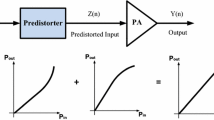Abstract
In this paper, a Takenaka–Malmquist–Volterra (TMV) model structure is employed to improve the approximations in the low-pass equivalent behavioral modeling of radio frequency (RF) power amplifiers (PAs). The Takenaka–Malmquist basis generalizes the orthonormal basis functions previously used in this context. In addition, it allows each nonlinearity order in the expanded Volterra model to be parameterized by multiple complex poles (dynamics). The state-space realizations for the TMV models are introduced. The pole sets for the TMV model and also for the previous Laguerre–Volterra (LV) and Kautz–Volterra (KV) models are obtained using a constrained nonlinear optimization approach. Based on experimental data measured on a GaN HEMT class AB RF PA excited by a WCDMA signal, it is observed that the TMV model reduces the normalized mean-square error and the adjacent channel error power ratio for the upper adjacent channel (upper ACEPR) by 1.6 dB when it is compared to the previous LV and KV models under the same computational complexity.






Similar content being viewed by others
Notes
In [5], a different approach based on a gradient descent procedure is proposed to search for the basis function poles. Such algorithm is fed with an approximation of the gradient descent cost function.
References
M. Bahoura, FPGA implementation of high-speed neural network for power amplifier behavioral modeling. Analog Integr. Circuits Signal Process. 79(3), 507–527 (2014)
S. Benedetto, E. Biglieri, R. Daffara, Modeling and performance evaluation of nonlinear satellite links a Volterra series approach. IEEE Trans. Aerosp. Electron. Syst. 15(4), 494–507 (1979)
R.H. Byrd, M.E. Hribar, J. Nocedal, An interior point algorithm for large-scale nonlinear programming. SIAM J. Optim. 9(4), 877–900 (1999)
S. Cripps, RF Power Amplifiers for Wireless Communications, 2nd edn. (Artech House, Norwood, MA, 2006)
R. Hacioglu, G.A. Williamson, Reduced complexity Volterra models for nonlinear system identification. EURASIP J. Appl. Signal Process. 4, 257–265 (2001)
P.S.C. Heuberger, P.M.J. Van den Hof, B. Wahlberg, Modeling and Identification with Rational Orthogonal Basis Functions (Springer, London, 2005)
M. Isaksson, D. Rönnow, A parameter-reduced volterra model for dynamic RF power amplifier modeling based on orthonormal basis functions. Int. J. RF Microw. Comput.-Aided Eng. 17(6), 542–551 (2007)
M. Isaksson, D. Rönnow, A Kautz–Volterra behavioral model for RF power amplifiers, in IEEE MTT-S International Microwave Symposium Digest, (San Francisco, CA, 2006), pp. 485–488
M. Isaksson, D. Wisell, D. Rönnow, A comparative analysis of behavioral models for RF power amplifiers. IEEE Trans. Microw. Theory Tech. 54(1), 348–359 (2006)
H. Jiang, P.A. Wilford, Digital Predistortion for Power Amplifiers Using Separable Functions. IEEE Trans. Signal Process. 58(8), 4121–4130 (2010)
P.B. Kenington, High Linearity RF Amplifier Design (Artech House, Norwood, 2000)
B.M. Lee, R.J.P. de Figueiredo, Adaptive predistorters for linearization of high-power amplifiers in OFDM wireless communications. Circuits Syst. Signal Process. 25(1), 59–80 (2006)
V. Mathews, G. Sicuranza, Polynomial Signal Processing (Wiley, New York, 2000)
S.D. Mitchell, G.H.C. Oliveira, Analysing a power transformer’s internal response to system transients using a hybrid modelling methodology. Int. J. Electr. Power Energy Syst. 69, 67–75 (2015)
F. Mkadem, M.C. Fares, S. Boumaiza, J. Wood, Complexity-reduced Volterra series model for power amplifier digital predistortion. Analog Integr. Circuits Signal Process. 79(2), 331–343 (2014)
B. Ninness, F. Gustafsson, A unifying construction of orthonormal bases for system identification. IEEE Trans. Autom. Control 42(4), 515–521 (1997)
G.H.C. Oliveira, W.C. Amaral, K. Latawiec, An introduction to models based on Laguerre, Kautz and other related orthonormal functions—Part II: non-linear models. Int. J. Model. Identif. Control 16, 1–14 (2012)
G.H.C. Oliveira, W.C. Amaral, K. Latawiec, CRHPC using Volterra models and orthonormal basis functions: an application to CSTR plants, in Proc. IEEE Control Applications Conf. (Istanbul, 2003), pp. 718–723
B. Özgül, J. Langer, J. Noguera, K. Vissers, Software-programmable digital pre-distortion on new generation FPGAs. Analog Integr. Circuits Signal Process. 78(3), 573–587 (2014)
W. Pan, Y. Liu, S. Shao, Y. Tang, A method to reduce sampling rate of the ADC in feedback channel for wideband digital predistortion. Circuits Syst. Signal Process. 33(8), 2655–2665 (2014)
J.C. Pedro, S.A. Maas, A comparative overview of microwave and wireless power-amplifier behavioral modeling approaches. IEEE Trans. Microw. Theory Tech. 53(4), 1150–1163 (2005)
M. Rawat, K. Rawat, F.M. Ghannouchi, S. Bhattacharjee, H. Leung, Generalized rational functions for reduced-complexity behavioral modeling and digital predistortion of broadband wireless transmitters. IEEE Trans. Instrum. Meas. 63(2), 485–498 (2014)
D. Raychaudhuri, N.B. Mandayam, Frontiers of wireless and mobile communications. Proc. IEEE 100(4), 824–840 (2012)
M. Schetzen, The Volterra and Wiener Theories of Nonlinear Systems (John Wiley, New York, 1980)
R. Schumacher, G.H.C. Oliveira, S.D. Mitchell, An iterative approach for selecting poles on complex frequency localizing basis function-based models. J. Control Autom. Electr. Syst. 26(4), 380–389 (2015)
B. Wahlberg, System identification using Kautz models. IEEE Trans. Autom. Control 39(6), 1276–1282 (1994)
Q. Zheng, E. Zafiriou, Nonlinear system identification for control using Volterra–Laguerre expansion, in Proc. American Control Conf. (Seattle, WA, 1995), pp. 2195–2199
A. Zhu, T.J. Brazil, RF power amplifier behavioral modeling using Volterra expansion with Laguerre functions, in IEEE MTT-S International Microwave Symposium Digest, (Long Beach, CA, 1979), pp. 963–966
Author information
Authors and Affiliations
Corresponding author
Rights and permissions
About this article
Cite this article
Schumacher, R., Lima, E.G. & Oliveira, G.H.C. RF Power Amplifier Behavioral Modeling Based on Takenaka–Malmquist–Volterra Series. Circuits Syst Signal Process 35, 2298–2316 (2016). https://doi.org/10.1007/s00034-015-0151-0
Received:
Revised:
Accepted:
Published:
Issue Date:
DOI: https://doi.org/10.1007/s00034-015-0151-0




